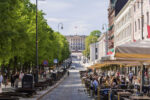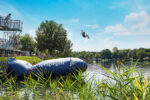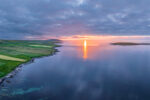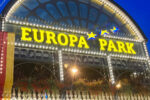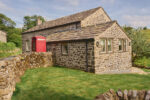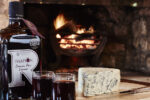Oslo to Bergen via Train & Boat: Norway In A Nutshell® – A Solo Travelogue – Travel Review
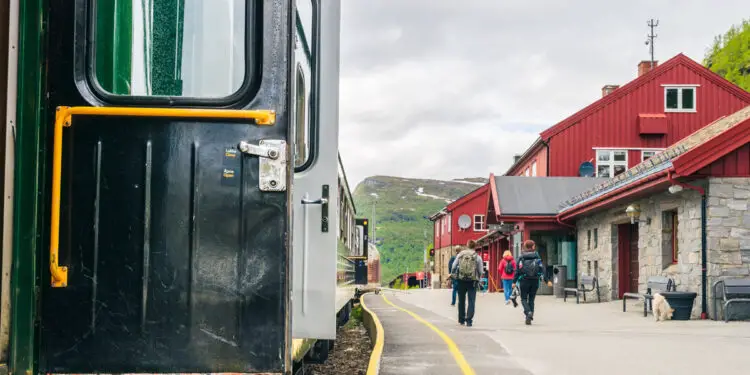
By Helen Johnston, September 2025
Is it possible to run out of adjectives to describe beautiful scenery? The answer is yes if you’re travelling the Norway in a Nutshell® route between Oslo and Bergen. This trip transports you by train, boat and coach through some of the most breathtaking vistas imaginable and is perfect for a first solo travel adventure.
Norway has been on my go-to list for a while and I wanted to experience as much as possible in the time I had available, so Norway in a Nutshell® by Fjord Tours was a perfect option to sandwich in between visits to Oslo and Bergen. There are various options but mine was the 12-hour trip from east to west which might sound gruelling, but for most of that time I was sitting comfortably and watching a never-ending display of natural beauty, so it’s not physically demanding.
After two days exploring Oslo, I headed to the city’s Central Station to board the 8.25am Bergen train. It set off on time (a pleasant surprise for those of us used to the inconsistencies of British trains), with a mixture of nationalities settling in for the long ride ahead. The full 300-mile journey to Bergen takes about seven hours but I was getting off at Myrdal where we would arrive just after 1pm.
That meant four-and-a-half hours on board, so it was a relief to find the seats were comfortable and there was plenty of room for luggage, given that nearly everyone had a case or large bag. There was a café on board too offering a decent selection of food and drinks. I had a window seat and sat next to Astrid, a Norwegian travelling home after a work conference in Oslo.
“Imposing mountains”
As with everyone else I spoke to in Norway, her English was excellent and she was able to provide information about the places we passed. She worked in recycling for her local council so it was no surprise when she said she preferred to use the more environmentally friendly train than fly, and she was still appreciative of the beautiful landscape despite having been surrounded by it all her life. “I’ve travelled by train a lot throughout Europe but I still love to come home to this,” she said, pointing out of the window.
We weren’t far out of Oslo before the scenery began to show off, teasing us with glimpses of water between trees before revealing an impossibly blue lake. And that was followed by another and then another, their glass-like water mirroring the scenery above them, imposing mountains clad in forests of trees. As the nine-carriage train snaked its way across country the woman in front of me kept her phone permanently at the window to take video after video, desperate to capture every minute of it.
We had left Oslo under blue skies and sunshine but as we continued west the sky grew cloudy and Astrid warned that the weather on that side of the country was usually wetter, pretty much the same as in the UK. We were climbing higher now, and the landscape grew barren. The Bergen Line opened in 1909 and is the highest railway in northern Europe and eventually we reached its highest station at Finse, some 1222 metres above sea level.
“Scenic railways”
An Australian couple sitting on the other side of the aisle alerted us to a view of two glaciers either side of a slope, which served as a reminder of how challenging it was to build a railway line across this inhospitable landscape. Astrid said this was where she had done some university research into beetles which are able to survive here, and she pointed out wooden huts which serve as accommodation for scientists.
From Finse the train crosses the Hardangervidda plateau with views of snow-capped mountains, the train continuing its sinuous journey until finally coming to a halt at Myrdal where many of us alighted to wait for the next train. This was to be the hour-long journey to Flåm along what has been described as one of the world’s most scenic railways. And with good reason.
The train had a vintage wooden interior with shorter seat backs and large picture windows designed to provide the best possible views. The Flåm Railway is 20km long and has 20 tunnels, one of which involves a 180-degree turn inside the mountain. It is a major feat of engineering and has one of the world’s steepest standard guage tracks with 80% of the journey on a 5.5% gradient. Construction began in 1923 and took 17 years to complete (take note HS2 builders) with the Nåli tunnel taking 11 years to build.
“Surreal encounter”
It’s difficult to comprehend such statistics on paper but when you’re on the train travelling through the mountains you can see first-hand the challenges faced by the construction workers. It’s a wonder anybody ever thought such a rail line was possible. One of the highlights of the route is the stop at Kjosfossen waterfall, which is only accessible by rail. It’s an impressive waterfall, crashing 93 metres down the mountain side and we were able to get off to take pictures.
While I was joining everyone else angling for a good photo, haunting music began to play, adding an ethereal air to the experience. Then I caught a glimpse of red on the mountain side as a woman with wild blonde hair came into view, wearing a long, scarlet dress and dancing Kate-Bush-doing-Wuthering-Heights style. This was a forest spirit called a Huldra and provided a surreal encounter with Norse mythology in a perfect setting.
I was sitting with a couple from Cambridge who were spending several weeks exploring Scandinavia by rail and were even planning to travel all the way home from Stockholm by land and sea because they want to cut down on flying. We agreed that train travel is a much better way to really see a country and its people.
“Meditative quality”
Commentary is provided on the train, pointing out particularly scenic views and also the 350-year-old wooden church at Flåm village, our final stop. It lies at the edge of Aurlandsfjord and whereas on the train the views were down at the valleys, now it was a case of craning your neck to look up at the majestic mountains surrounding the head of the fjord. A huge cruise ship dwarfed the harbour side and made me wonder how on earth it had managed to squeeze its way through to this spot. For the next stage of my trip was a cruise (on a much smaller boat) along the Nærøyfjord, the narrowest arm of the Sognefjord and a UNESCO world heritage site.
This was a ‘silent’ cruise on an electric boat without commentary which really allows passengers to enjoy the quiet of this breathtaking space. The water was as calm as a mill pond enabling the boat to glide gracefully along with the towering majesty of the 1700-metre-high mountains on either side. You can move freely around the boat during the two-hour journey, and I stayed on deck for most of it to enjoy the meditative quality of the experience. It was cold and breezy on the upper deck though, even on a late summer day, so it’s a good idea to have layers to wrap up in.
When it got a bit too chilly, I went inside to warm up with a hot drink and some food. There was a good selection at the on-board café and plenty of comfortable seating and large windows, so it was still possible to enjoy the views. Colourful hamlets hugged the shoreline at various places, waterfalls tumbled down, and the sheer sheerness of the mountain sides was awe-inspiring. Some of the wooden homes could only be reached by boat and I wondered what it must be like to live somewhere so cut off. Although maybe it doesn’t feel that way when you’ve got tourists passing by so frequently.
“Seen so much”
The cruise ends in Gudvangen where we picked up a coach to take us to Voss. About half an hour after setting off we made a photo stop at Stalheim to take in the breathtaking views of the Nærøydalen Valley. This was when I ran out of adjectives to describe what I was seeing. It was simply stunning. The view is accessed through a hotel which had a gift shop in the lobby but I didn’t mind that because they were giving us the present of that view (as well as a complimentary sweet bread called lefse). Then it was back on the coach to continue our now rainy journey to Voss station where we picked up the train to Bergen for our final leg of the trip.
By now it was 7.15pm and the light was fading under the rain clouds, but it was still possible to see rivers rushing along beside the track, lovely scenery but which now seemed a bit tame in comparison to what had gone before. I chatted with some Americans, a couple from Cincinatti and a woman from Fort Worth, and we compared travel notes. We were following different routes, but we all agreed that Norway had lived up to our expectations.
Tiredness was starting to take over now and, as we sped along, the carriage gradually grew silent as heads drooped and eyes closed. I reflected on how easy this route is to travel solo with easy-to-follow directions at every point and never any misgivings about safety. I had found companions to chat with and learn from all along the way and had never really felt alone.
It was dark when we disembarked at Bergen at 8.40pm and I still had another short journey to do by tram to my hotel at the marina. Later, replaying the journey in my head it was hard to fathom how I’d seen so much in one day. Mountains and lakes, check. UNESCO-listed fjord, check. Glaciers and snow, check. Forests and lush green fields, check. Had I seen Norway in a Nutshell®? I certainly had.
A standard tour from Oslo to Bergen for one person starts at 2510 Norwegian Krone (about £185 depending on exchange rates)
You can start the tour in either Oslo or Bergen and take it as a round trip or one way. You can also personalise your tour by booking overnight stays and activities along the route.
For more information and to book go to Fjord Tours at fjordtours.com
Top image: Casper Steinsland
Frequently Asked Questions about Norway in a Nutshell®
What is Norway in a Nutshell®?
A scenic, self-guided journey linking trains, the Flåm Railway, a fjord cruise and coach transfers between Oslo and Bergen (or vice versa), showcasing lakes, glaciers and UNESCO-listed fjords.
How long does the trip take?
Durations vary by route and season. The itinerary described here took around 12 hours travelling east to west in a single day.
What are the main stops and highlights?
Oslo – Myrdal – Flåm – Gudvangen – Voss – Bergen, including the high-altitude Bergen Line (Finse at 1,222 m), the Flåm Railway, Kjosfossen waterfall, Aurlandsfjord and the UNESCO-listed Nærøyfjord, plus the Stalheim viewpoint.
Is it suitable for solo travellers?
Yes. Connections are well signposted with easy-to-follow directions. The journey is largely seated and felt safe throughout, with plenty of opportunities to meet fellow travellers.
What is special about the Flåm Railway?
It runs 20 km through 20 tunnels, features a 180-degree turn inside the mountain and is among the world’s steepest standard gauge lines, with around 80% at a 5.5% gradient.
Is there commentary?
Onboard commentary highlights key sights on the trains. The fjord leg described was a silent electric cruise without commentary to preserve the tranquillity.
What should travellers wear and bring?
Layers are essential – it can be breezy on deck even in late summer. Bring water, snacks, a power bank, and space on your phone for photos; cafés are available on trains and boats.
How much does it cost?
At the time of writing, standard one-way tours start from 2,510 NOK (about £185, exchange rates vary). Always check current prices before booking.
Can the tour be customised?
Yes. Travellers can start in Oslo or Bergen, travel one way or round-trip, and add overnight stays and activities along the route.
How do you book?
Directly via Fjord Tours: Norway in a Nutshell®. Schedules and inclusions can vary by season.
Is the trip physically demanding?
No – most of the day is seated on trains and boats, with short, straightforward transfers between connections.






